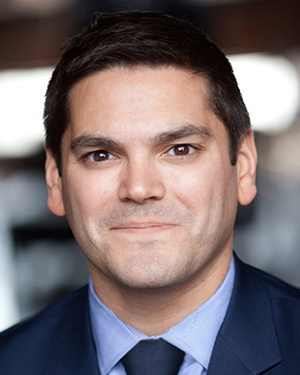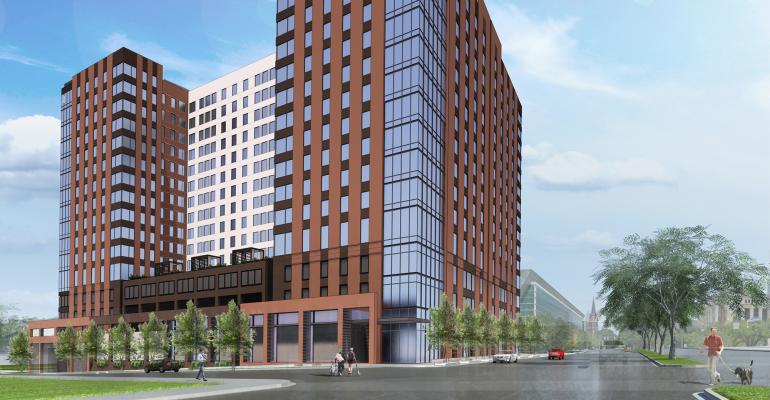In July, CRG, based in Chicago, and Landmark Properties, based in Athens, Ga., started construction on the Standard at Columbia, a 17-story student housing apartment featuring 678 beds that will open in time for the fall 2023 academic year at the nearby University of South Carolina.
Landmark Properties is one of the largest private developers and operators of student housing while CRG, the real estate development and investment arm of Chicago-based Clayco, a design build construction company. CRG has developed across myriad property types and recently brought on new managing director, J.J. Smith, who has 13 years of experience working in the student housing sector at Chicago-based CA Ventures.
The partnership in South Carolina may be just the beginning for Landmark and CRG’s Smith.
WMRE caught up with Smith to get that details on the deal that brought the two firms together.
This interview has been edited for style, length and clarity.
WMRE: What is the synergy that you get when two developers come together?
 J.J. Smith: I was really looking for two things when I made the phone call to Landmark. One was help procuring capital on the project and two, having an operating company to manage the property when it was built. So with Landmark I was able to fill two needs for the property with one phone call. It’s been the first of what we believe might be many projects together.
J.J. Smith: I was really looking for two things when I made the phone call to Landmark. One was help procuring capital on the project and two, having an operating company to manage the property when it was built. So with Landmark I was able to fill two needs for the property with one phone call. It’s been the first of what we believe might be many projects together.
WMRE: Would the financing have been possible without the partnership?
J.J. Smith: From April all the way until the fall semester in August, there was a five-month period when on-campus experience seemed in jeopardy or at least in question.… I had to make a judgment call on whether it was better to continue to solicit capital directly or work with a more established name in the space.
Landmark, they have built more than 50,000 beds in the last 10 years. They really have a great name in the sector and a lot of capital chasing projects that they are executing.
I really have had a good relationship with the founder of that company, Wes Rogers. We have known each other for about 13 years or more. We were well-respected competitors for many years. The projects that I executed for many years at CA Ventures—often we were competing for the land, the same development sites.
We each bring something different to the project. I bring the opportunity, the design, the permitted project and the construction expertise. They bring their financial relationships and their operating company.
It closed in late July… the joint venture as well as the financing with Citizen’s Bank and CapitaLand, a foreign REIT based in Singapore, which provided equity. Thetotal development cost is about $100 million, with the loan at about $65 million.
WMRE: Do the terms of CapitaLand's equity investment show anything about the current market for student housing investments?
J.J. Smith: This is a firm validation of how well student housing fared amidst the pandemic and how foreign investors view post-pandemic student housing's viability given that the sector proved to be not only recession resilient in 2009 to 2012 but also pandemic resilient in 2020.
It used to be very uncommon to see global institutional investors in student housing until about 2013-2014 and over the last five years. Foreign investment has really picked up, representing a majority of the new inflow of capital to the sector.
WMRE: Is CapitaLand a repeat investor for your team or for Landmark? Are they likely to become repeat investors?
J.J. Smith: CapitaLand has a couple projects underway with Landmark. This is the first with CRG and we are likely to seek more opportunities together.
WMRE: Are the expectations changing with investors like CapitaLand regarding communications, reporting, disbursements, etc.?
J.J. Smith: With global investors, the sector is placing more emphasis on environmental, sustainability and governance when developing and operating these assets. But communications, reporting and disbursements have always been of great importance to the investors. We are now utilizing technology to keep this information at investor fingertips including the use of including the use of video and drones to report progress.
WMRE: What about the terms of the construction loan are different that you would have received at a different time?
J.J. Smith: Not too different, actually. The leverage is about the same as it would have been pre-pandemic as well as the rate.
WMRE: Tell us a little about Columbia S.C. How does this project fit into the “flight from cities?”
J.J. Smith: It’s a capital city… education plus medicine plus government is a powerful combination for job creation and job growth.… I do believe that students want to be near the downtown in Columbia and not necessarily on the outskirts of town—a lot of student housing was built a few miles from campus. There really was only one competitor in the downtown of Columbia that was targeting the students. We viewed our location to be a sweet spot balancing the best of both worlds—the education and some of the more social amenities the downtown can afford… both the downtown retail and nightlife as a well as proximity to campus.
WMRE: How did Columbia do during the pandemic?
J.J. Smith: It fared very well. Not a lot of storefronts have gone dark.… We saw in the college towns retail typically hold up pretty well, particularly in the towns that had other economic engines nearby, in this case government.… The demographic that attends Tier One universities isn’t really the type that wants to take coursework from their bedroom at their parents’ house back home. Also, in the case of South Carolina the university has grown dramatically over the last few years. There really hasn’t been a lot of new supply.
WMRE: Is there anything about this deal, the design the location, that lets you know it is happening right now?
J.J. Smith: During the pandemic people prioritized space more than anything, even location… This building was designed to have a one-to-one ratio of beds to baths. Also, the amount of space that we give to amenities has certainly crept up. So before the pandemic, we might include 20 sq. ft. per occupant in terms of amenity. Today that’s at least 25 to 30 sq. ft. per occupant. The number of units came down a little to make room for the amenity space. Most of our projects have 200 to 250 units. I would say we reduced that amount 5 percent.





